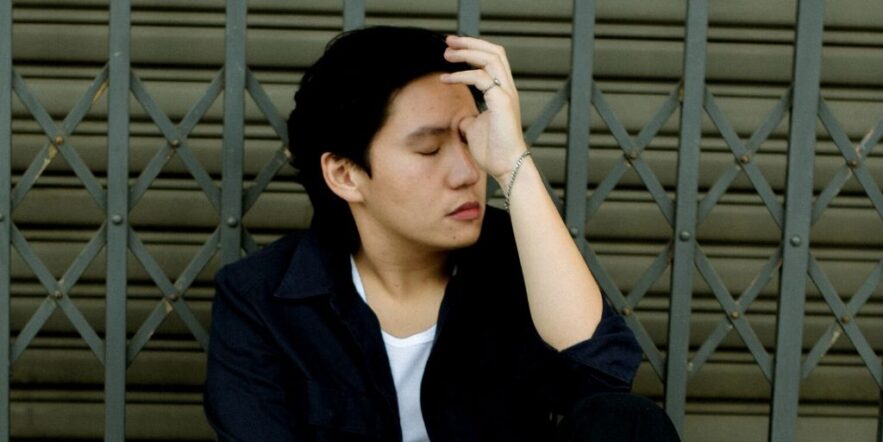Browse This Article
Different techniques that have been proven to control anxiety.
When Lisa Jones was in college, her once-manageable anxiety became overwhelming. “I was having three or four panic attacks a day,” she says. “My hands were shaking. I felt I needed to run and hide. I would hyperventilate sometimes to the point of blacking out. I knew I needed help to lessen anxiety.”
Lisa’s doctor referred her to Frances P. Thorndike, PhD, an assistant professor in the department of psychiatry and neurobehavioral sciences at the University of Virginia Health System, in Charlottesville, who also has a private practice. Lisa’s doctor had prescribed medication, and Thorndike recommended that she also start a program of cognitive behavioral therapy (CBT), a technique that gives patients tools to control their own anxiety. Lisa also began meditating, starting with 10 minutes a day, on her own.
Lisa very quickly started to see results. “Even though the treatment didn’t immediately cut down the number of panic attacks, I felt better,” she says. “I felt like I had control, and I didn’t have to let the panic attack take over my life.”
Lisa, who wasn’t opposed to medication, decided to hold off and try the therapy alone first. Still, knowing the medication was available gave her comfort. “It was helpful to know that it was OK to take it if I needed it,” she says. There is ample evidence that techniques including CBT, meditation, sleep strategies, and exercise can help people with an anxiety disorder. People who try these techniques may still need medication, however, to manage extreme symptoms, help get them through the first stages of therapy, or, like Lisa, to keep on the shelf for a “break-glass-in-case-of-emergency moment.”
CBT: Tools for Living and Lessen Anxiety
Many studies show that CBT can teach people with an anxiety disorder to manage their condition. A study published in Behavioral Research and Therapy, tracked 361 people with panic disorder as they completed an 11-session course of CBT. The study showed “strong evidence” that CBT reduced panic symptoms.
“Medications for anxiety disorder can certainly be helpful,” explains Thorndike. “But CBT actually changes thought patterns and behaviors that cause anxiety and keep it going.”
If you choose this type of therapy you will learn techniques to cope with your situation and feelings, and those techniques will be tailored to your unique situation, Thorndike says. You will learn techniques to deal with anxiety, including relaxation and deep breathing, as well as cognitive tools – things you can say to yourself to challenge and control your fears. Eventually, you will practice using these techniques when exposed to your trigger, the situation that produces anxiety.
“We start gradually,” Thorndike says. For example, if someone is afraid of dogs, “we may start by looking at pictures of dogs, and then going to a park and watching them from a distance,” she says. To find a therapist who practices CBT ask your doctor or try the Find a Therapist Directory of the Anxiety and Depression Association of America (ADAA).
Liston to Christopher Williams, who is living with borderline personality disorder, describe some of the types of therapy he’s found helpful for managing the condition, which can cause anxiety and paranoia among other symptoms.
@medshadow_foundation Christopher Williams talks to MedShadow Foundation about borderline personality disorder. #mentalhealth #mentalhealthmatters #healthandwellness #mentalhealthawareness #health #bpd #mentalhealthtiktoks #borderlinedisorder #therapy #therapytok #therapytiktok #therapysessions #medshadow #medshadowfoundation #borderlinepersonalitydisorder #borderlinepersonality #borderliner ♬ Stories 2 – Danilo Stankovic
Many therapists now offer telemental health, telepsychology, or online therapy over the internet through email, video conferencing, online chat, or a phone call, which can make it easier for some people to get treatment. In a report on 34 web-based anxiety intervention programs published in the Journal of Medical Internet Research: Mental Health, researchers note that internet CBT programs had improved outcomes equal to face-to-face therapy. However, they conclude that there is a need for guidelines and standards for developing these programs, and services that provide reliable, up-to-date information on their quality and how to access them. The American Psychological Association offers a number of points to consider before choosing an online therapy program, like whether the therapist is licensed or the app is secure. If you want to try an online program, Thorndike recommends you use Beacon 2.0, to search for the right program.
While one-to-one therapy is ideal, you can also try to learn some of these techniques on your own. Thorndike recommends starting with The Anxiety and Phobia Workbook by Edmund J. Bourne (New Harbinger Publications, 7th edition, 2020).
Mindfulness Meditation for Lessen Anxiety: Living in the Moment
Another technique that has been proven to control anxiety is mindfulness meditation. This is a type of meditation that teaches you to be aware of the present moment—your thoughts, emotions, and sensations—with an attitude of acceptance. (See MedShadow’s How Meditation Helps My Patients Heal)
Elizabeth Hoge, MD, an associate professor in the department of psychiatry and director of the anxiety disorders research program at Georgetown University School of Medicine in Washington, DC, is a psychiatrist with a specialty in anxiety disorders. For her 2013 study on mindfulness meditation, published in the Journal of Clinical Psychiatry, 93 people diagnosed with generalized anxiety disorder (GAD) were asked about their symptoms and put through a stress test both before and after training. Half had training in mindfulness meditation, and half attended an education class. Those who learned to meditate had less stress on the second test than those who didn’t, says Dr. Hoge, who is also affiliated with the Center for Trauma and the Community at Georgetown University Medical Center.
In Hoge’s 2018 study in Psychiatry Research, one group of patients with GAD attended a class in mindfulness-based stress reduction and another GAD group attended a control class that did not teach mindfulness. Before and after the classes the patients were tested for blood levels of stress markers. The patients in the mindfulness group had significantly greater reductions in stress markers compared to the control group, leading Hoge and colleagues to conclude that mindfulness-based interventions can enhance resilience to stress.
Why does meditation help?
“Mindfulness meditation starts with a practice of focusing on your breath,” says Dr. Hoge. “As your thoughts arise, you are taught to just notice them there, like a cloud passing in the sky, and not react to them.” With practice, people with anxiety disorder can use these techniques to control their reactions to negative thoughts in daily life.
While any form of meditation will help, she says, her research uses mindfulness meditation, which is derived from vipassana or insight, meditation. You can find information on insight meditation at the website of the Insight Meditation Society, www.dharma.org. There are also many books on meditation technique, including Wherever You Go, There You Are by Jon Kabat-Zinn (originally published by Hyperion, 1994).
Get Your Rest
Sleep and anxiety are intertwined, says Thorndike. “People who are anxious may struggle with falling asleep or wake up during the night,” she says. Being overtired can make people more prone to anxiety and less able to cope with its symptoms as well, she adds.
Try some simple steps to improve your sleep at night. “Your bed should be saved only for sleep or sex,” she says. “If you are awake for more than 15 or 20 minutes, leave the room. Don’t lie in bed and worry.” It is also important to keep screens, phones, and TV out of the bedroom, maintain consistent bed and wake times, avoid caffeine in the afternoon and avoid exercising late in the evening.
If you’re having trouble sleeping, consider trying an online CBT program for insomnia. For example, an app called Somryst delivers CBT digitally through a smartphone or a tablet. Studies show these programs can be helpful for insomnia. In a review of studies on the use of digital CBT for insomnia, researchers found that the evidence supporting its use is strong. In their 2019 study published in Current Psychiatry Reports, the researchers suggest that digital CBT has the ability to reach many more people with insomnia than could ever be reached with fact-to-face CBT.
And in another 2019 study, more than 1,700 people with insomnia were assigned to undergo therapy via either an online CBT program or sleep hygiene education. Reporting in JAMA Psychiatry, the researchers were investigating whether digital CBT could lead to sleep-related improvements in psychological well-being and quality of life. People using the online program reported significantly greater improvements in insomnia that led to reductions in psychological symptoms, including anxiety, compared to the education group. (See MedShadow’s How to Kick Insomnia Without Turning to Pills.)
Get Moving
Exercise can help as well, Thorndike says. A meta-analysis of 16 studies on resistance exercise (strength training) for anxiety found that this type of exercise significantly improved symptoms of anxiety. The analysis, published in the journal Sports Medicine and including more than 900 men and women, revealed that anxiety improvements were seen in healthy people as well as those with physical or mental illnesses.
A review of studies on the mental health benefits of regular exercise, published in Frontiers in Psychology, notes that both aerobic and resistance exercise (strength training) can reduce anxiety. In one study, published in the journal Mental Health and Physical Activity, researchers tested the effects of resistance training and aerobic exercise on signs and symptoms of GAD. Sedentary women aged 18 to 37, diagnosed with GAD and taking medication for it, were assigned to six weeks of resistance training, aerobic exercise or a wait list. Compared to the group that did not exercise, both exercise groups experienced improvements in symptoms associated with GAD, particularly anxiety, concentration, irritability, fatigue, pain and vigor.
Many people find that practicing yoga helps them find relief from anxiety as well as stay fit. While the practice has not been cleared as a treatment for diagnosed anxiety disorders, studies show it can help people manage symptoms of anxiety and depression. Experts compare yoga’s stress reduction benefits to those achieved through socializing with friends, exercise, meditation or deep relaxation.
Even if you are out of shape, “start wherever you can, depending on your fitness level,” Thorndike says. “It is only important to do it regularly and consistently.” Eventually, try to build up to exercising at least 30 minutes three times weekly.
For Lisa, a little more than a year of therapy gave her the tools she needs to manage her anxiety daily. Today, she meditates daily, practices yoga, and uses the skills she learned from Thorndike. “I still get the symptoms of panic attacks,” she says. “I still have all the same triggers. But when I feel the attack coming on, I can use these tools to squash it.”
More from MedShadow
7 Natural Remedies to Relieve Anxiety
For more information
Exercise for Stress and Anxiety (Anxiety and Depression Association of America)
Psychotherapies (National Institute of Mental Health)







